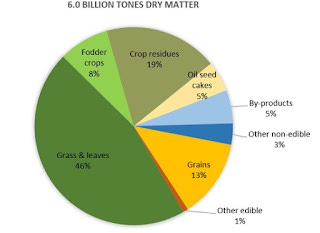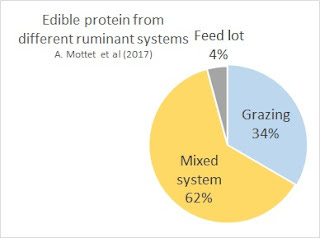Are pigs eating our food?
We are told that increased meat consumption is driving environmental destruction. But what if it is the other way round?
For each person on the planet, about 1500 kcal of plants is used daily to feed animals. In return we get just some 500 kcal per capita per day in the form of animal foodstuffs. The 1000 kcal that is “lost” in this transformation would be enough to feed another 3 billion people. Isn’t it a no-brainer that we rather should eat plants than animals? One could think so. But the reality is a bit more complicated than that. A recent paper from Anne Mottet, Livestock Development Officer, and colleagues from the FAO, Livestock: On our plates or eating at our table?, goes far in giving a better big picture understanding of the role of livestock in our food system.
“I came to realize that people are continually exposed to incorrect information about livestock and the environment that is repeated without being challenged, in particular about livestock feed,” says Anne Mottet. “There is currently no official and complete international database on what livestock eat. This study contributes to fill this gap and to provide peer-reviewed evidence to better inform policy makers and the public.”
The researchers have calculated the total feed intake of domesticated livestock (measured in dry matter) and as can be seen from the pie chart 46% of all feed are grass and leaves. The second most important feed are crop-residues (straw, stover etc.) with 19%, while grains (maize, wheat, barley etc.) account for 13% of the global livestock dry matter intake. Other by-products from the food chain (in particular from the milling, drink and food industry) supply 5% of the feed, while oil seed cakes contribute another 5%. Notably, oil seed cake is partly a by-product as well. Global consumption of vegetable oil has skyrocketed after WW II and almost all vegetable oils have a waste production in the form of oil seed cake. Large scale cultivation of soybeans was first driven by soy oil demand, and still todaysoy oil is the second most important oil in the world and contributes one third of the income from soy growing.

http://www.sciencedirect.com/science/article/pii/S2211912416300013 Around 30% of the total acreage, some 210 million hectares, of cereal production is used for livestock feed, in addition 66 million hectares are used for the cultivation of hay, silage and other fodder crops. Together that makes 275 million hectares of land used for crops dedicated to feed production, slightly less than 20% of all arable land. If you add the proportion of feed coming from other crops (e.g. the straw or chaff from grain grown for food or oil seed cakes) one could consider that another 260 million hectares are used for feed production. But in the context of “people could eat what is eaten by animals” it makes little sense to add these as the alternative use of these residues and by-production is as energy, industrial raw materials or fertilizers and not food for humans.
The study found that an average of only 3 kg of cereals are needed to produce 1 kg of meat at global level. But it also shows important differences between production systems and species. For example, because they rely on grazing and forages, cattle need only 0.6 kg of protein from human edible feed to produce 1 kg of protein in milk and meat, which is of higher nutritional quality. For backyard chicken and pigs only 0.1 kg of human edible protein is used to produce 1 kg of human edible protein while for industrial systems between 2.9 and 5.2 kg of human-edible protein is used per kg of protein. By and large, traditional animal raising systems are an efficient way of producing high value food, which actually is quite self-evident as our ancestors certainly couldn’t afford any large scale waste of valuable food.
For ruminants, around one third of the protein in livestock products comes from pure grazing systems and 62% comes from mixed systems (system where animals graze to some extent, and where the feed has a considerable proportion of roughage) while only 4% of the ruminant protein come from feed lot systems. For poultry the situation is very different, where only 4% are estimated to be kept in backyard systems, i.e. small scale systems where animals are fed scraps, waste or find their own food here and there. One fourth of the pigs are raised in backyard systems and 56% in pure industrial systems. So poultry certainly eat food that people could eat, pigs as well to some extent, but ruminants are hardly guilty on a global scale.

While almost half of all livestock feed comes from grazing, because of low productivity of most grasslands huge areas are used for grazing. The statistics are notoriously unreliable, but the researchers state that the global area of grasslands is 3.5 billion hectares. Only 2 billion hectares, i.e. less than 60%, are grazed by domesticated livestock, however, the remainder is only grazed by wildlife, or not at all. The researchers claim that one third of this could possibly be converted to arable land. In the rest of the land the natural limitations are too big to allow for crop production. When I look at their map, however, I think their assessment is very optimistic. For example the map indicates that most of the southern part of Sweden has grasslands that could be converted to crop fields. While there certainly are such lands, my assessment is that most of what is classified as permanent grasslands in Sweden (not arable land which is grazed) is not convertible to cropping.
Grassland, top ten countries 1000 hectares China, mainland 392833 Australia 358962 United States of America 251000 Brazil 196000 Kazakhstan 187465 Saudi Arabia 170000 Mongolia 112364 Argentina 108500 Russian Federation 93000 South Africa 83928 Source: FAOSTAT
It is important to consider the wider value of animal products in the diet. On a calorific basis they are “wasteful”, less so for protein as we have seen above. 40% of all dietary protein comes from animals (34% from livestock and 6% from fish and seafood). Around 45% of all dietary fat comes from animals and many of those fatty acids are unique for animal fat, and here there is no waste at all in feed conversion as animals get very little fat in their diets. Recent research in the USA, concluded that if the US food system changed into a vegan diet, there would be a huge increase in supply of calories and protein, but shortage in some essential fatty acids, vitamin B12 and vitamin A as well as Calcium.
While the focus of the paper is the role of animals in providing food, the researchers also point out that animals add to agricultural production through manure production and drought power. Further, keeping livestock provides a secure source of income for over 500 million poor people in many in rural areas. In addition, animal products are an important source of fuel and as an industrial raw material. * We are told that increased meat consumption is driving environmental destruction. But what if it is the other way round? It is the constant increase in productivity of the worlds’ farmers, with the assistance of chemical fertilizers, pesticides, fossil fuels, breeding and technology that has created an enormous surplus of agriculture raw materials, in particular wheat, soy, maize, sugar and palm oil.

There are no additional 3 billion people out there eating all that extra output. The surplus has driven prices down and made it possible to use grain for purposes which earlier were rare, such as bio fuels and animal feed. Under industrial farming conditions it is simply more profitable to use grown plants for feeding pigs and chicken than to have backyard systems. In almost all rich countries the acreage of grasslands are shrinking because it is “cheaper” and “more efficient” to give cows grown fodder and grain, despite the fact that grazing has very low direct cost and very low resource use. Since 2000 the global acreage of grassland has decreased with some 3% according to FAOSTAT.
By and large, the industrialisation of farming is the main driver of the expansion of livestock production. Under Swedish conditions a worker had to work eight times longer sixty years ago to earn the price of a chicken. No wonder global chicken consumption has increased 12 times in the same period!



